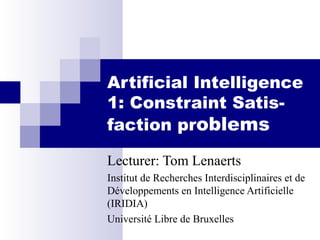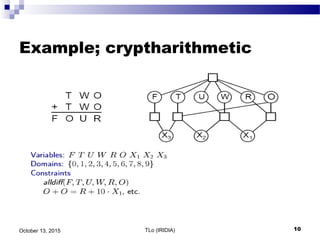This document discusses constraint satisfaction problems (CSPs) and techniques for solving them. It begins by defining CSPs as problems with variables, domains of possible values, and constraints limiting assignments. Backtracking search and heuristics like minimum remaining values are described as standard approaches. Constraint propagation techniques like forward checking and arc consistency are explained, which aim to detect inconsistencies earlier. The 4-queens problem is provided as an example CSP.












![TLo (IRIDIA) 13October 13, 2015
Commutativity
CSPs are commutative.
The order of any given set of actions has no effect
on the outcome.
Example: choose colors for Australian territories
one at a time
[WA=red then NT=green] same as [NT=green then
WA=red]
All CSP search algorithms consider a single variable
assignment at a time ⇒ there are dn
leaves.](https://image.slidesharecdn.com/5-csp-151013043305-lva1-app6891/85/5-csp-13-320.jpg)

![TLo (IRIDIA) 15October 13, 2015
Backtracking search
function BACKTRACKING-SEARCH(csp) return a solution or failure
return RECURSIVE-BACKTRACKING({} , csp)
function RECURSIVE-BACKTRACKING(assignment, csp) return a solution or failure
if assignment is complete then return assignment
var ← SELECT-UNASSIGNED-VARIABLE(VARIABLES[csp],assignment,csp)
for each value in ORDER-DOMAIN-VALUES(var, assignment, csp) do
if value is consistent with assignment according to CONSTRAINTS[csp] then
add {var=value} to assignment
result ← RRECURSIVE-BACTRACKING(assignment, csp)
if result ≠ failure then return result
remove {var=value} from assignment
return failure](https://image.slidesharecdn.com/5-csp-151013043305-lva1-app6891/85/5-csp-15-320.jpg)





![TLo (IRIDIA) 21October 13, 2015
Minimum remaining values
var ← SELECT-UNASSIGNED-VARIABLE(VARIABLES[csp],assignment,csp)
A.k.a. most constrained variable heuristic
Rule: choose variable with the fewest legal moves
Which variable shall we try first?](https://image.slidesharecdn.com/5-csp-151013043305-lva1-app6891/85/5-csp-21-320.jpg)






![TLo (IRIDIA) 28October 13, 2015
Example: 4-Queens Problem
1
3
2
4
32 41
X1
{1,2,3,4}
X3
{1,2,3,4}
X4
{1,2,3,4}
X2
{1,2,3,4}
[4-Queens slides copied from B.J. Dorr CMSC 421 course on AI]](https://image.slidesharecdn.com/5-csp-151013043305-lva1-app6891/85/5-csp-28-320.jpg)
















![TLo (IRIDIA) 45October 13, 2015
Arc consistency algorithm
function AC-3(csp) return the CSP, possibly with reduced domains
inputs: csp, a binary csp with variables {X1, X2, …, Xn}
local variables: queue, a queue of arcs initially the arcs in csp
while queue is not empty do
(Xi, Xj) ← REMOVE-FIRST(queue)
if REMOVE-INCONSISTENT-VALUES(Xi, Xj) then
for each Xk in NEIGHBORS[Xi ] do
add (Xi, Xj) to queue
function REMOVE-INCONSISTENT-VALUES(Xi, Xj) return true iff we remove a value
removed ← false
for each x in DOMAIN[Xi] do
if no value y in DOMAIN[Xi] allows (x,y) to satisfy the constraints between Xi and Xj
then delete x from DOMAIN[Xi]; removed ← true
return removed](https://image.slidesharecdn.com/5-csp-151013043305-lva1-app6891/85/5-csp-45-320.jpg)




![TLo (IRIDIA) 50October 13, 2015
Local search for CSP
function MIN-CONFLICTS(csp, max_steps) return solution or failure
inputs: csp, a constraint satisfaction problem
max_steps, the number of steps allowed before giving up
current ← an initial complete assignment for csp
for i = 1 to max_steps do
if current is a solution for csp then return current
var ← a randomly chosen, conflicted variable from VARIABLES[csp]
value ← the value v for var that minimizes CONFLICTS(var,v,current,csp)
set var = value in current
return faiilure](https://image.slidesharecdn.com/5-csp-151013043305-lva1-app6891/85/5-csp-50-320.jpg)










